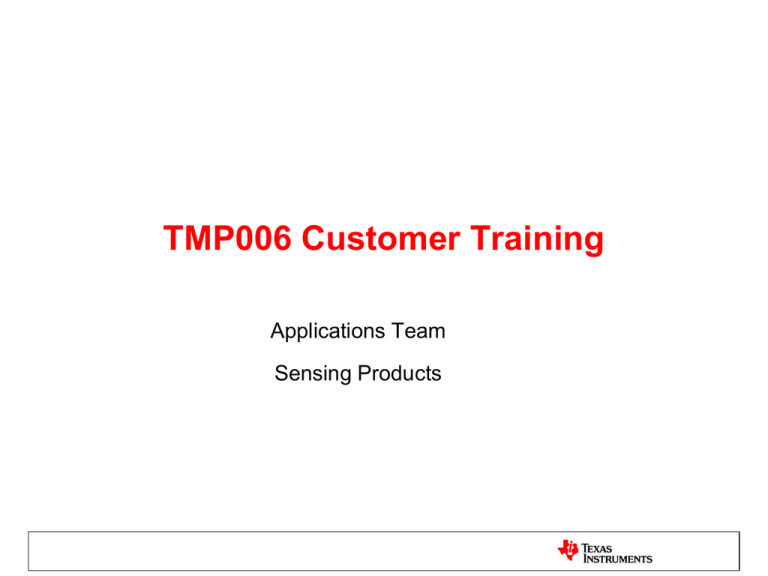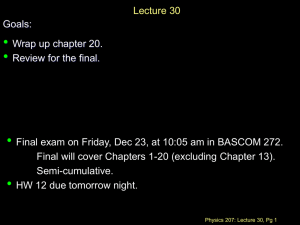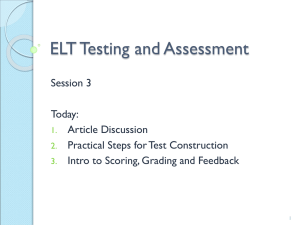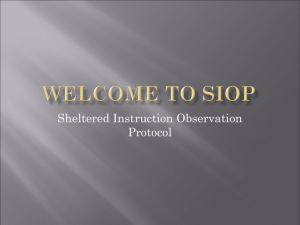TMP006 Customer Training
advertisement

TMP006 Customer Training Applications Team Sensing Products What is a Thermocouple / Thermopile Thermocouple Thermopile + + Tcold Thot - Vout Thot Thot Vout Tcold Thot Heat Absorber Heat Sink Thot Heat Absorber - Cold Junction Vout = G x (Thot – Tcold) Vout = n x G x (Thot – Tcold) G: Seebeck Constant G: Seebeck Constant Heat Transfer (1): Conduction • Conduction: Heat is transferred through direct touch. – Example: Touching a hot cup of coffee Heat Transfer (2): Convection • Convection: Heat is transferred by a moving liquid or gas. – Example: Fan cooling Heat Transfer (3): Radiation • Radiation: Heat is transferred by waves (photons) – Example: The warmth you feel from the sun – The amount of energy radiated is dependent on the absolute (Kelvin) temperature of the object. Device Principle of Operation Object Infrared Radiation TMP006 PCB TMP006 at its core is a heat sensor. It converts the heat being transferred to a voltage. PCB Recommended Layout • The sensor at it’s core is a heat sensor and is sensitive to conduction and convection in addition to radiation. • Recommended PCB layout isolates the sensor from the rest of the PCB GND Via Connecting to Circuit Thermal Break Copper Dot TMP006 Conduction & Convection Offsets • The sensor, is a heat sensor at its core. It will detect heat from all three sources: conduction, convection, and radiation. • The signal created by heat conduction and convection is relatively small in a setup with the recommended PCB layout but it is not zero. • Calibration is needed to cancel out remaining offsets Field of View Consideration (1) • For best performance it is recommended that the diameter of object is 4 times the distance to the TMP006 sensor. • d = h – 250µm • object size ≥ 4×d Case object size ≥ 4d distance = d h TMP006 PCB Field of View Consideration (2) • For best performance it is recommended that the diameter of object / opening is 4 times the distance to the TMP006 sensor. • d = h – 250µm • Opening size ≥ 4×d Case/Lens opening size ≥ 4d heat sink distance = d h TMP006 PCB Emissivity Considerations • Not all objects emit the same amount of energy at the same temperature. • Emissivity is the ratio of energy radiated by an emitter to the theoretical ideal emitter. Emissivity is always less than one. • Since the emissivity may change for different systems, then the system gain will need to be calibrated. TMP006 Equation Needs calibration. Depends on field of view and emissivity of object S S0 1 a T 1 die T ref a T 2 die System independent: No need to calibrate T ref V os b 0 b1 T die T ref b 2 T die T ref f V obj V obj V os c 2 V obj V os 2 2 2 Models voltage offset due to conduction & convection. System dependent & needs calibration System independent: No need to calibrate T obj 4 T 4 die f (V obj ) S Transient Correction Basics • The hot junction is isolated from the rest of the sensor by the sensor’s thermal resistivity • When the sensor’s cold junction temperature is changed through heat conduction from the outside, the hot junction follows, but is delayed by a time constant • This effect can be modeled with a first order RC filter that delays the hot junction relative to the sensor substrate temperature Thot Cth Thermopile Tcold + Rth Tcold Thot • Rth Thermal resistance of thermopile • Cth Thermal capacitance of thermopile Heat Absorber Heat Sink - Vout Tcold Thot time Temperature Temperature Transient Error Example Tcold Thot time Transient Correction Basics (2) V Err Seebeck V Err V Err T Cold t T Cold t T Cold t A temperature gradient is created on the thermopile during transients that is proportional the slope of the transient itself. This gradient generates a voltage error through the Seebeck effect. R th C th Seebeck R th C th α Seebeck R th C th 2 .96 10 -4 (V sec / C) Alpha is a constant which corresponds to the multiplication of Seebeck constant and the thermal time constant With transient correction Without transient correction Effect of Transient Correction Coefficient Calibration • Coefficients that get calibrated are: S0, b0, b1 & b2 • Before calibrating the coefficients, transient correction should be applied to the sensor’s output voltage to cancel out the transient effects. • At this point in time it is recommended that the customer send us the data of their system and we will provided a custom set of “b” coefficients for optimum accuracy. • An automatic calibration software is being developed at this point and should be available for customer use in the near future Setting Up The System For Calibration Object Reference Temperature Sensor (Example: TMP112) Glued to object using thermal epoxy TMP006 PCB • For calibration: the data from the reference: Tobj as well as the TMP006 data: Tdie & Vout need to be collected simultaneously. Calibrating S0 S S 0 1 a 1 T die T REF a 2 T die T REF V os b 0 b1 T die T REF b 2 T die T REF V obj 1 V os 1 4 4 T obj 1 T die 1 S1 T 4 obj 2 T 4 die 2 V obj 2 V os 2 S2 2 2 To be able to accurately calibrate S0 you need at least two points with the same Tdie values but different Tobj values. More than one measurement is recommended to reduce the effect of noise if T die 1 T die 2 V os 1 V os 2 V os S1 S 2 S T obj 2 T obj 1 4 S0 4 T 4 obj 2 V obj 2 V obj 1 S V obj 2 V obj 1 S 0 1 a 1 T die T REF a 2 T die T REF V obj 2 V obj 1 T obj 1 1 a 1 T die T REF a 2 T die T REF 4 2 2 Calibrating “b” Coefficients T 4 die V obj V os S V os V obj S T obj T die 4 4 V os b 0 b1 T die T REF b 2 T die T REF • The residual offset based on the calibrated S0 value is calculated according to the equation above. • The calculated offset is drawn versus (Tdie – Tref) and a second order curve fit for the data is done to calculate the b0, b1 and b2 coefficients. 2 Vos = Vobj – S(Tobj4 – Tdie4) T 4 obj 2nd order curve fit (use excel) Coefficients of curve fit are b0, b1 and b2 Tdie – Tref Importance of the Number and Range of Points y-axis Error at the extreme points Calibrated curve based on only middle three points Actual device behavior Points collected don’t exactly match the actual curve due to noise x-axis • The larger the number of points the lower the effect of noise. • The further apart the points are the better the correction. Calibrated coefficients Default coefficients Default Versus Calibrated Coefficients









